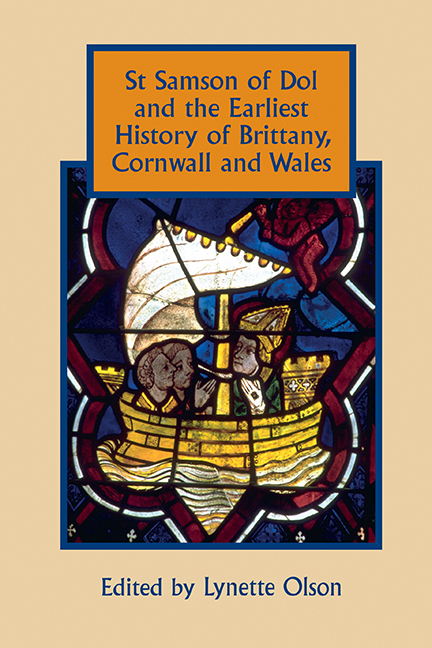Book contents
- Frontmatter
- Contents
- List of Tables
- Editor's Preface
- Map: Places associated with St Samson in the First Life
- 1 Introduction: ‘Getting Somewhere’ with the First Life of St Samson of Dol
- 2 A Family and its Saint in the Vita Prima Samsonis
- 3 La Circulation de l'information dans la Vie ancienne de s. Samson de Dol et la question de sa datation
- 4 The Hare and the Tortoise? Vita Prima Sancti Samsonis, Vita Paterni, and Merovingian Hagiography
- 5 Columbanus, the Britons, and the Merovingian Church
- 6 Apostolic Authority and Celtic Liturgies: from the Vita Samsonis to the Ratio de cursus
- 7 The Representation of Early British Monasticism and Peregrinatio in Vita Prima S. Samsonis
- 8 Present and Yet Absent: the Cult of St Samson of Dol in Wales
- Bibliography
- Index
- Studies in Celtic History
8 - Present and Yet Absent: the Cult of St Samson of Dol in Wales
Published online by Cambridge University Press: 05 July 2018
- Frontmatter
- Contents
- List of Tables
- Editor's Preface
- Map: Places associated with St Samson in the First Life
- 1 Introduction: ‘Getting Somewhere’ with the First Life of St Samson of Dol
- 2 A Family and its Saint in the Vita Prima Samsonis
- 3 La Circulation de l'information dans la Vie ancienne de s. Samson de Dol et la question de sa datation
- 4 The Hare and the Tortoise? Vita Prima Sancti Samsonis, Vita Paterni, and Merovingian Hagiography
- 5 Columbanus, the Britons, and the Merovingian Church
- 6 Apostolic Authority and Celtic Liturgies: from the Vita Samsonis to the Ratio de cursus
- 7 The Representation of Early British Monasticism and Peregrinatio in Vita Prima S. Samsonis
- 8 Present and Yet Absent: the Cult of St Samson of Dol in Wales
- Bibliography
- Index
- Studies in Celtic History
Summary
Vita I Samsonis (VIS) is an unusual source with a particularly complex composition. We remain frustrated by the things it does not tell us, or at least fails to tell us in definitive terms, but many recent studies have shed new light on its evidence both for the saint and for the context of its writing. Some of the remaining challenges posed by VIS concern its status as a work of hagiography and its relationship to the cult of St Samson. Past studies placed the composition of the text very early in the seventh century (Duine) and as late as the early ninth (Fawtier). The current near-consensus appears to place it toward the middle of these polarities, ca 700. It is a truism that the dissemination of the cult of the saint is often a largely separate matter to the travels of the saint him- or herself – although this truism was flagrantly ignored by the school of archaeo-geographical study of British saints, led by such scholars as E.G. Bowen and Gilbert H. Doble, which still bears strongly on debates. Our reassessments of the date and nature of VIS may mean that it has a particular contribution to make to considerations of the connection between saint and cult. The hagiographer himself claimed to have journeyed through the landscape of Samson's own origins and to have seen in it locations that are directly related to Samson. In some cases these may be sites of a cult, or an incipient cult, of the saint. In Wales, strikingly, none of these sites became – or at least survived as – a conventional dedication to St Samson, in contrast to the substantial number of dedications to St Samson in Brittany as well as in Cornwall. It is both the present and absent evidence for a cult of Samson that will interest us here. Readings of VIS have led to the imposition of Samson of Dol onto ambiguous data, especially landscape data, which I will consider here in detail. I will also consider whether VIS, written as it was partly on the basis of its author's visits to Wales as well as Cornwall, offers potential insights into the process by which church leaders became culted as saints – acting as a control on the validity of our truisms concerning the formation, persistence, and perhaps disappearance of cults.
- Type
- Chapter
- Information
- Publisher: Boydell & BrewerPrint publication year: 2018



